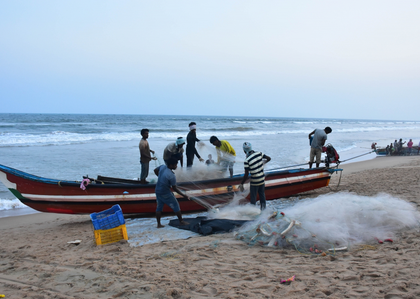Migrant labourers form backbone of Kerala's marine fisheries: CMFRI study
By IANS | Updated: August 27, 2025 19:15 IST2025-08-27T19:12:04+5:302025-08-27T19:15:11+5:30
Kochi, Aug 27 Migrant labourers constitute the majority of Kerala’s marine fisheries workforce, accounting for nearly 58 per ...

Migrant labourers form backbone of Kerala's marine fisheries: CMFRI study
Kochi, Aug 27 Migrant labourers constitute the majority of Kerala’s marine fisheries workforce, accounting for nearly 58 per cent of the sector, according to a new study by the ICAR-Central Marine Fisheries Research Institute (CMFRI).
The research, covering harvest, post-harvest, and market segments, highlights the critical role of migrant workers in sustaining the state’s fishing economy.
The findings, part of a national project on the changing dynamics of labour migration in Indian marine fisheries, were presented at a consultative workshop held at CMFRI on Wednesday.
The study revealed that Munambam harbour in Ernakulam district has Kerala’s highest concentration of migrant labourers in the mechanised fishing sector, with 78 per cent of the workforce hailing from outside the state.
Most of them come from Tamil Nadu, West Bengal, and Odisha.
Migrants also constitute 50 per cent of workers in post-harvest units and 40 per cent in fish markets.
A key concern flagged by the study is the waning interest of younger generations, both locals and migrants, in pursuing livelihoods in the marine sector, raising questions about the long-term sustainability of the labour force.
The research also highlighted sharp contrasts in expenditure and lifestyle.
While native workers spend 20–30 per cent of their income on savings, education, and housing, migrants remit up to 75 per cent of their earnings back home.
Many live on boats or in makeshift shelters with minimal spending on housing or amenities in Kerala.
Migrant incomes were found to be consistently lower, averaging Rs 25,000 per month in harvest centres compared to natives’ Rs 30,000, and as little as Rs 11,000 in post-harvest jobs.
Despite their dominance, migrant workers remain highly vulnerable, facing exploitation, health risks, and a lack of social security.
Native labourers, meanwhile, struggle with inadequate income, indebtedness, off-season unemployment, and limited credit access.
Migrants additionally deal with identity crises, isolation, and occasional conflicts with local workers.
The study “Labour Mobility Grid” identified poverty and unemployment in source states as key push factors, while higher wages and demand in Kerala serve as strong pull factors.
Fisheries Deputy Director Dr Maja Jose assured that the government would consider measures to address the concerns of migrant workers.
CMFRI Director Dr. Grinson George called for urgent policy interventions in housing, health coverage, education support, and livelihood diversification to ensure labour welfare in the fisheries sector.
Disclaimer: This post has been auto-published from an agency feed without any modifications to the text and has not been reviewed by an editor
Open in app